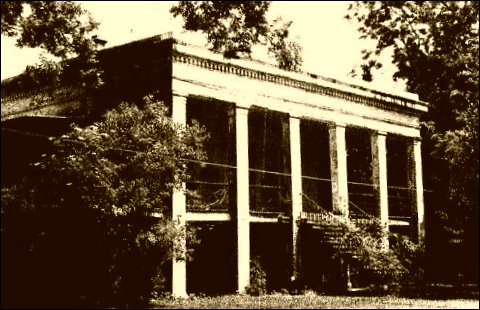

BELLE ALLIANCE PLANTATION Located on the east bank of Bayou Lafourche in Assumption Parish, about five miles out of Donaldsonville, Louisiana is Belle Alliance Plantation. Originally this 7,000 acre plot was a grant to Don Juan Vives, a physician and military officer of the Spanish government. Vives took part in the 1779 expedition against the British in Baton Rouge which was led by Spanish governor Don Bernardo Galvez. Vives received the Bayou Lafourche land grant and was knighted by the Spanish king. This settlement became known as Valenzuela during Spain's long occupation of Louisiana, and was a Spanish military outpost. Belle Alliance Manor was built by Charles (Carl) Anton Kock, a German immigrant in 1846 on the site of an earlier house that was destroyed by fire in 1830. Eighteen year old Charles Kock, with a few personal belongings, boarded a steamship in the harbor at his home town of Bremen, Germany, and sailed to America, the land of opportunity. Charles was the son of prominent businessman Johan Englebert Kock, a successful iron and steel merchant, and Marie Rebeckka Schroeder, both of Bremen, Germany. When Charles arrived in America, Louisiana was in the midst of great prosperity. Taking advantage of the active commercial relations between Louisiana and Bremen, Charles soon found work with a rich French cotton merchant named Pescatore, who was in the business of importing and exporting. In 1842 using a small inheritance from his deceased mother, Charles was able to go into business for himself as a commission merchant. Two years later in 1844, at the age of 32, Charles married 17 year old Jeanne Heda Longer, daughter of a wealthy Creole family in New Orleans. A few years later, Charles purchased several tracts of the sugar cane land from the Spanish descendants of Vives. The couple built and moved into their grand estate, and started a life of sugar cane production. The massive Greek Revival manor contains thirty-three rooms, including a rear wing added at a later date which is two-storied. The six great square columns extend directly from the ground and continue to the entablature, pausing to support the main floor veranda at a line nine feet from ground level. Large cast-iron bolts connect the veranda skirt line to each column and are quite deliberately ornamented to emphasize their presence. Lovely cast-iron railings border the veranda, spanning from column to column across the front and returning towards the rear of each end. There they meet iron railings between colonnettes, and a canopy forming a typical side gallery that is covered with a flat room comes out from below the entablature and is supported by grills of cast iron. The house and columns are brick covered with stucco. The simple entablature is moulded of the same materials with only a dentil course to give it a touch of the ornate. The driveway, an elongated half oval leading back to the house, touched the highway at each corner of the grounds. Massive oaks shaded the grounds on either side of the mansion. On each side of the front drive were massive gates bearing the Kock crest, two lions and a crown. The space within the oval driveway was converted into gardens with shrubbery, fountains, statuary, roses and seasonal flowers. Belle Alliance became famous for its magnificent camellias. On July 21, 1869, Charles Anton Kock, patriarch of the Kock family, passed from this life. At the death of his father, operation of Belle Alliance plantation was taken over by Charles Kock's eldest son, Edouard. Not too long afterwards, James P. Kock, the youngest son, was called on by Edouard to assist him in management of Belle Alliance. Only July 18, 1884, Edouard Kock unexpectedly passed away at the age of thirty-six, leaving James, the only surviving son of Charles Kock, complete control of Belle Alliance plantation. He became the most successful and innovative planter in Assumption parish and enjoyed great personal popularity. On September 1, 1915, James P. Kock died at the age of sixty and Belle Alliance was soon lost afterwards. Source: Library of Congress, Prints and Photographs Division, Historic American Buildings Survey, (HABS LA,4-DONA.V,1-) Submitted by Bob Franks
|